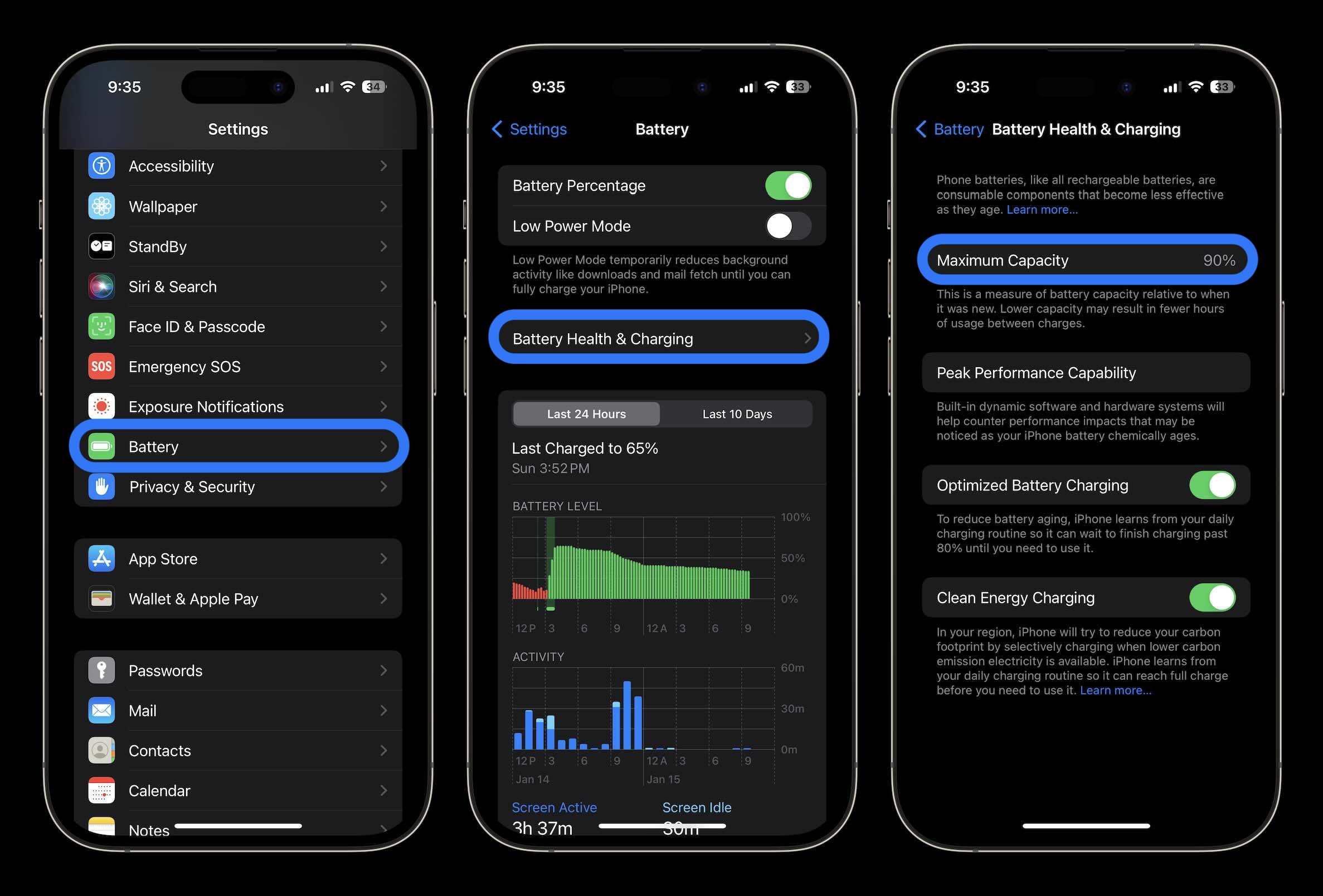
Whether you’re just curious how your iPhone battery health is holding up or you’re having issues with battery life or unexpected shutdowns, it’s easy to check in iOS Settings. Below we’ll cover how to see iPhone battery health, tips on when to get a replacement, charge cycle expectations, and more.
iPhone 14 and 15 devices have the most expensive out-of-warranty battery replacements at $99. But we also saw a change in March 2023 that increased battery replacements for all of Apple’s older iPhone models by $20. That pushed iPhone 13 through iPhone X up to $89 and iPhone SE, iPhone 8, and earlier to $69.
If you upgrade your iPhone every year or two, you hopefully shouldn’t have an issue with a degraded battery, unless you end up with a defective one.
But for those who have iPhones that are two years old or older, low battery health ends up being an inevitability at some point due to chemical aging along with how many charge cycles they’ve gone through.
How to see iPhone battery health
- Open the Settings app on your iPhone
- Swipe down and tap Battery
- Now choose Battery Health & Charging
- Your current battery capacity is shown at the top

When should you replace an iPhone battery?
- TL;DR: When your battery has dropped below 80% of its original capacity you may want to consider a replacement. Same if you see a warning about your battery being degraded or if it won’t hold a charge.
- Under the “Battery Health & Charging” section shown above, you should see a warning if your battery health is degraded and if it’s causing issues like unexpected shutdowns and/or unable to sustain peak performance.
- Apple says iPhone batteries are “designed to retain up to 80% of its original capacity at 500 complete charge cycles when operating under normal conditions.”
If you’re in the US, replacements are covered under the one-year included warranty or with AppleCare. However, if you’re out of warranty coverage, Apple charges a $69-99 fee for the iPhone battery replacement service.
When an iPhone battery drops below 80% of its original capacity, a feature called “performance management” may be automatically applied. This works to help prevent unexpected shutdowns.
However, it is possible to turn the performance throttling off. Look for the small “Disable” button at the end of the text below “Peak Performance Capability.”
If you see a message that says battery health degraded or unknown, head to an Apple Store, reach out to Apple Support, or an Apple Authorized Service Provider if you want to get a certified Apple battery replacement.
How are charge cycles measured?
Here’s Apple’s description of how a charge cycle is determined:
You complete one charge cycle when you’ve used (discharged) an amount that equals 100% of your battery’s capacity — but not necessarily all from one charge. For instance, you might use 75% of your battery’s capacity one day, then recharge it fully overnight. If you use 25% the next day, you will have discharged a total of 100%, and the two days will add up to one charge cycle. It could take several days to complete a cycle.
You can read more specifics about iPhone battery and performance in Apple’s full support document. Thanks for reading our guide on how to see iPhone battery health!
Check out more 9to5Mac tutorials:
FTC: We use income earning auto affiliate links. More.

Whether you’re just curious how your iPhone battery health is holding up or you’re having issues with battery life or unexpected shutdowns, it’s easy to check in iOS Settings. Below we’ll cover how to see iPhone battery health, tips on when to get a replacement, charge cycle expectations, and more.
iPhone 14 and 15 devices have the most expensive out-of-warranty battery replacements at $99. But we also saw a change in March 2023 that increased battery replacements for all of Apple’s older iPhone models by $20. That pushed iPhone 13 through iPhone X up to $89 and iPhone SE, iPhone 8, and earlier to $69.
If you upgrade your iPhone every year or two, you hopefully shouldn’t have an issue with a degraded battery, unless you end up with a defective one.
But for those who have iPhones that are two years old or older, low battery health ends up being an inevitability at some point due to chemical aging along with how many charge cycles they’ve gone through.
How to see iPhone battery health
- Open the Settings app on your iPhone
- Swipe down and tap Battery
- Now choose Battery Health & Charging
- Your current battery capacity is shown at the top

When should you replace an iPhone battery?
- TL;DR: When your battery has dropped below 80% of its original capacity you may want to consider a replacement. Same if you see a warning about your battery being degraded or if it won’t hold a charge.
- Under the “Battery Health & Charging” section shown above, you should see a warning if your battery health is degraded and if it’s causing issues like unexpected shutdowns and/or unable to sustain peak performance.
- Apple says iPhone batteries are “designed to retain up to 80% of its original capacity at 500 complete charge cycles when operating under normal conditions.”
If you’re in the US, replacements are covered under the one-year included warranty or with AppleCare. However, if you’re out of warranty coverage, Apple charges a $69-99 fee for the iPhone battery replacement service.
When an iPhone battery drops below 80% of its original capacity, a feature called “performance management” may be automatically applied. This works to help prevent unexpected shutdowns.
However, it is possible to turn the performance throttling off. Look for the small “Disable” button at the end of the text below “Peak Performance Capability.”
If you see a message that says battery health degraded or unknown, head to an Apple Store, reach out to Apple Support, or an Apple Authorized Service Provider if you want to get a certified Apple battery replacement.
How are charge cycles measured?
Here’s Apple’s description of how a charge cycle is determined:
You complete one charge cycle when you’ve used (discharged) an amount that equals 100% of your battery’s capacity — but not necessarily all from one charge. For instance, you might use 75% of your battery’s capacity one day, then recharge it fully overnight. If you use 25% the next day, you will have discharged a total of 100%, and the two days will add up to one charge cycle. It could take several days to complete a cycle.
You can read more specifics about iPhone battery and performance in Apple’s full support document. Thanks for reading our guide on how to see iPhone battery health!
Check out more 9to5Mac tutorials:
FTC: We use income earning auto affiliate links. More.